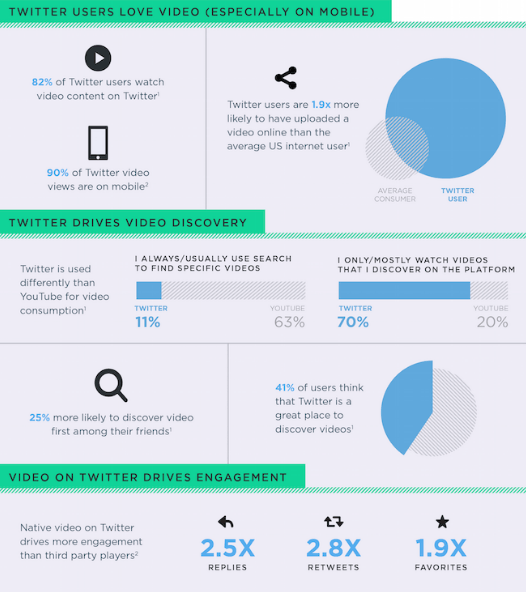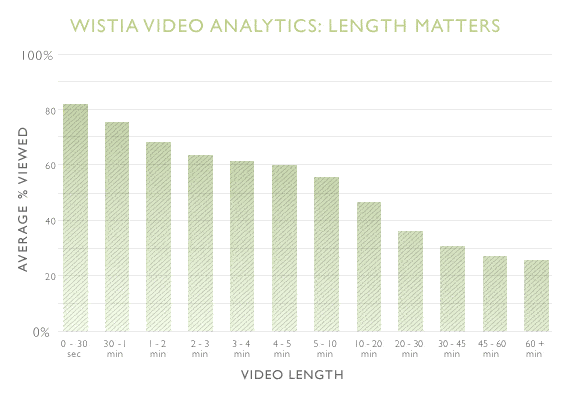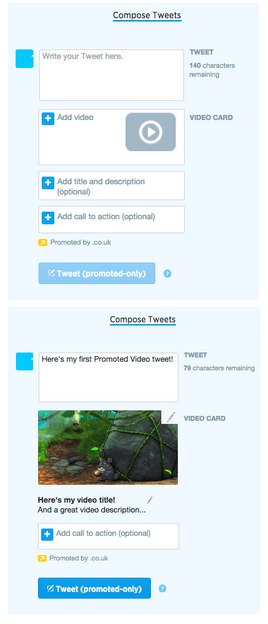While there are several different types of Twitter ads to choose from — Promoted Tweets, Promoted Trends, and Promoted Accounts — the very best Twitter ads are those that contain videos.
Videos can be exceptionally dynamic and are an excellent way to evoke emotion and put some extra enthusiasm into your Twitter posts. Additionally, more than half of marketing professionals worldwide believe that video is the type of content with the best ROI. Therefore, it should come as no surprise that Twitter video ads substantially increase awareness, engagement, and traffic.
In fact, according to Twitter, users are three times more likely to engage with Tweets that contain photos and videos than with Tweets that don’t include any photos or videos. What’s more is that videos on Twitter actually drive the most recall, emotional connection, and engagement than videos on any other digital platform.
Let’s take a closer look at how and why this is.
What are Twitter video ads?
A Twitter video ad is any Twitter ad that uses video to drive action. Although there are many different forms of Twitter advertising, there are two main types of Twitter video ad formats: Promoted videos and pre-roll ads.
Promoted videos appear natively in users’ timelines or feeds, and can be up to ten minutes long. Pre-roll ads, on the other hand, appear just before a content partner’s video as part of the Twitter Amplify ad program, and are anywhere from 30 seconds to 10 minutes. Both Promoted videos and pre-roll ads autoplay on mute as users scroll through their timelines.
The image below shows the Google Trend in “Twitter video ads” from 2010 to present day:
trends.embed.renderExploreWidget(“TIMESERIES”, {“comparisonItem”:[{“keyword”:”Twitter video ads”,”geo”:”US”,”time”:”2010-01-01 2019-03-11″}],”category”:0,”property”:””}, {“exploreQuery”:”date=2010-01-01%202019-03-11&geo=US&q=Twitter%20video%20ads”,”guestPath”:”https://trends.google.com:443/trends/embed/”});
While Twitter video ads serve the same purpose as other forms of Twitter advertising — to increase engagement, brand awareness, traffic to websites, etc. — they differ regarding pricing.
For example, when you run a website clicks or conversion campaigns, you’re charged for each click to your website. When you run a follower campaign, like Promoted Accounts, you are charged for each follower you acquire. When it comes to video ad campaigns on Twitter, you’re charged per view of your video. So what constitutes a view?
There are two different ways to bid here. One is to count a view when your video is at least 50% in-view on the user’s screen and has been watched for at least two seconds, or when the user clicks the video to watch it in fullscreen. The other bidding option, new as of May 2016, is to bid on the 3s/100 metric, which counts a view when your video is 100% in-view on the user’s device and watched for at least three seconds. Since this is a bit rarer, it saves marketers some campaign money.
Along with the new bidding option, Twitter video ads have seen some additional changes over the past year. In February 2016, Twitter launched First View — a highly engaging way for a brand to share its story using compelling video, by claiming the top ad spot in users’ timelines:
 Then in September, Twitter upgraded its Twitter Amplify video-ad platform, allowing select users to make money from their video creations.
Then in September, Twitter upgraded its Twitter Amplify video-ad platform, allowing select users to make money from their video creations.
Now that we’ve examined what Twitter video ads entail, how they’re becoming increasingly popular and how they’re different from other types of Twitter advertising; let’s now look at some important Twitter video statistics, followed by some best practices for Twitter video campaigns.
Twitter video statistics
- 82% of Twitter users watch video content on Twitter.
- Native videos on Twitter drive more engagement than third-party videos shared on Twitter. Specifically, 2.5x more replies, 2.8x more retweets, and 1.9x more likes/favorites.
- 65% of senior marketing executives believe that visual content, like photos, videos, and infographics, are essential to communicating their brand story.
- Twitter users are 1.9x more likely to upload a video to Twitter than the average US Internet user is to upload a video to another platform on the Internet.
- 55% of users say that they’ve spent time on social media watching branded video ads.
- 43% of users say that after viewing a video ad, they’ve gone on to like or follow that brand.
- 76% of users have visited a company’s website after watching one of their video ads on social media.
- 41% of users say that they’ve bought a product or service after watching a video ad on social media.

Best practices for Twitter video ads
Just because Twitter video ads are effective and drive impressive engagement doesn’t mean you can pick a video at random and expect to reach your marketing goals. There are some best practices you should keep in mind when creating your Twitter video ad campaign:
1. Tell users why they should view your video
Surround your video with some compelling context. Explain to users why they should click on and play your video all the way through. Also, be sure to use an engaging call-to-action to encourage users to interact with your video, and of course, don’t forget to include relevant hashtags!
2. Make your video short and sweet
Don’t let it drag on too long, and don’t feel like you need to use the entire allotted ten minutes for your Promoted Video. Users are much more likely to become disengaged with your video if it goes on too long. In fact, research shows that over 80% of users will only watch a full video if it’s 30 seconds or less. So if your video goes beyond 30 seconds, make sure you at least convey your message within the first 30 seconds.

3. Make sure your videos are mobile-friendly
These days, nearly 90% of all Promoted Videos are viewed on a mobile device. Therefore, it’s critical that you make sure the requirements and dimensions of your video are compatible with all mobile devices so that users are able and likely to engage.
4. Use highly engaging types of videos
Choosing a type of video to use depends on your overall social media marketing goals, but it’s still important to keep in mind that some types of videos are simply more engaging than others. Some highly engaging types of videos include:
- Educational videos are great for building brand awareness. Showing your followers how to solve a certain problem establishes you as a reliable authority. The more they trust your expertise, the more likely they are to consume and share your content. Plus, we’re living in the information age — people love “how to” content!
- Product videos should be used if you’re introducing a new product or showcasing a new feature of a product. Consider posting about these in advance, before you release your video, to build anticipation with your audience.
- FAQ videos are perfect for answering frequently asked questions via video clips. Since customer service teams tend to hear the same questions over and over, answering those FAQ with video messages saves them a ton of time, and increases customer retention, too.
- Behind-the-scenes videos help to build personal and meaningful relationships with your customers by giving them an idea of what goes on behind closed doors. Strong relationships translate to loyal customers in the long run. And as we all know, loyal customers have a much higher customer lifetime value.
- Lead gen teaser videos are ideal for driving leads because they allow you to advertise your content just like a TV commercial would. Another option is to give viewers a preview of what they’ll receive if they submit their contact information. This also helps boost conversion rates.
- Customer success story videos highlight a job well-done by your customers, rewarding them for using your product or service. This allows other potential customers to see the chances of being successful with your brand as well, so it’s a win-win for all parties included.
Twitter video ads vs. other platforms’ video ads
Although other social media platforms like Facebook and YouTube exceed Twitter regarding video views and ad spend, Twitter’s video ads are certainly still very worthy of advertisers’ time and marketing efforts.
Here are some of the main differences between Twitter video ads and other social media platforms’ video ads:
- While Twitter offers 30+ seconds pre-roll ads that appear just before a content partner’s video, YouTube is currently phasing out most of its 15-second and 30-second pre-roll non-skippable ads, and replacing them with skippable TrueView campaigns, supplemented by 6-second pre-roll non-skippable ads. Facebook does not offer any pre-roll ads at this time, as all of their video ads appear as native posts within the newsfeed.
- As previously mentioned, there are two ways to count a view on Twitter. The first is when the video is at least 50% in-view on the user’s screen and has been watched for at least 2 seconds. The second is when the video is 100% in-view on the user’s device and is watched for at least 3 seconds. Slightly different than Twitter, Facebook counts a view when the video is at least 50% in-view and watched for at least 3 seconds.
- Unlike other social media platforms, Twitter offers two unique targeting features: real-time and community targeting.
Real-time targeting is when marketers target users who are actively engaging with TV shows or live events like sporting events or award shows. Targeting these users ensures that their ads are seen by relevant and engaging users.
Community targeting is a targeting option that allows marketers to reach followers of other users to engage networks beyond interest or keyword targeting. Focusing on these users allows brands to target the followers of complementary brands, competitor brands, and influential thought leaders within the same niche.
How brands are using Twitter video ads
Countless brands are using Twitter video ads to create brand awareness, drive Twitter post-click landing page traffic, and increase sales. This should come as no surprise since Twitter videos drive more recall, emotional connection, and engagement than videos on any other digital platform.
Let’s examine some examples of brands who use Twitter video ads for marketing purposes:
1. Insider
Below is an example of Insider using a video to advertise a unique brownie recipe. Notice that the Tweet copy isn’t very long at all — just a short, simple description of the video. The video is also short and sweet (only one minute long) so viewers don’t get bored with it before the end. Plus, there is a link to the brand’s website right in the top corner of the video, making it easy for viewers to visit the website when they are done watching:
2. Universal Orlando
This is an example of Universal Orlando using a Twitter video to advertise a Promoted Trend. This 8-second video is simple but the hope is that viewers will find it intriguing enough to make them wonder what butterbeer is. In order to further promote the trend, the brand uses the hashtag #Butterbeer in their Tweet copy:
3. AMC Theatres
AMC Theatres uses a unique technique with their Twitter video ad. The video is advertising a Coke and a popcorn combo deal for $5, seen in the video and in the Tweet copy. The Tweet copy also contains a clear CTA, “follow the link to get the deal now”, followed by the link visitors are supposed to click on:
Upon clicking the link, visitors are taken to a click-through page, where they see the hashtag, #cupgrade, as well as a ‘Next’ button. After clicking the ‘Next’ button, users are brought to a form page where they can submit their birthday to get their #Cupgrade deal. Upon submitting their date of birth, users are then presented with a coupon code for their $5 Coke and popcorn deal. Finally, after clicking the ‘save to images’ button on that page, users are given the opportunity to share their #cupgrade with their friends, either on Facebook or Twitter. This allows more customers to get the deal, and increases brand awareness for both AMC and Coca Cola – a win-win-win.
How to set up a video views campaign on Twitter:
Step 1: If you don’t already have one, set up a Twitter Ads account:

Step 2: Once you’re logged in, select the ‘Create a new campaign’ button and from the dropdown, select the ‘Video views’ option.

Step 3: Next, you must give your campaign a name and choose the start and end dates for the campaign. For ongoing marketing messages, Twitter recommends selecting the first option, “Start immediately, run continuously” and setting your maximum daily budget to whatever amount you wish to spend per day. If you follow Twitter’s recommendation, your ad set will run until you manually stop it.

Step 4: This is where you’ll compose your Tweet. First, enter the Tweet copy in the top box (don’t forget to use relevant hashtags).
Then, select ‘Add video’ in the second box, and you will see all the videos that you have uploaded to your library. From these, select the video that you want to promote, and you should see a Video Card thumbnail appear in the box.
Next, enter a title and description for your video that viewers will see once they click to expand the video card. In the last box, enter an acceptable call-to-action for your video (Twitter supports “Visit site” and “Watch now” CTAs). Finally, click the ‘Tweet’ box at the bottom of the page to promote your video:

Visit Twitter’s business website for additional tips and instructions on setting up targeting for your Video Views campaign.
Get started using videos for your Twitter advertising
Twitter video ads can be an extremely effective way of generating traffic, leads, and sales for your marketing campaigns. Setting up Twitter video ads is only half of the equation, though. To get the most out of your Twitter video ads and convert your traffic, it’s best to set up optimized post-click landing pages designed specifically for conversion.
Start creating your own fully optimized post-click landing pages today with Instapage, sign-up for an Enterprise demo today.

See the Instapage Enterprise Plan in Action.
Demo includes AdMap™, Personalization, AMP,
Global Blocks, heatmaps & more.



